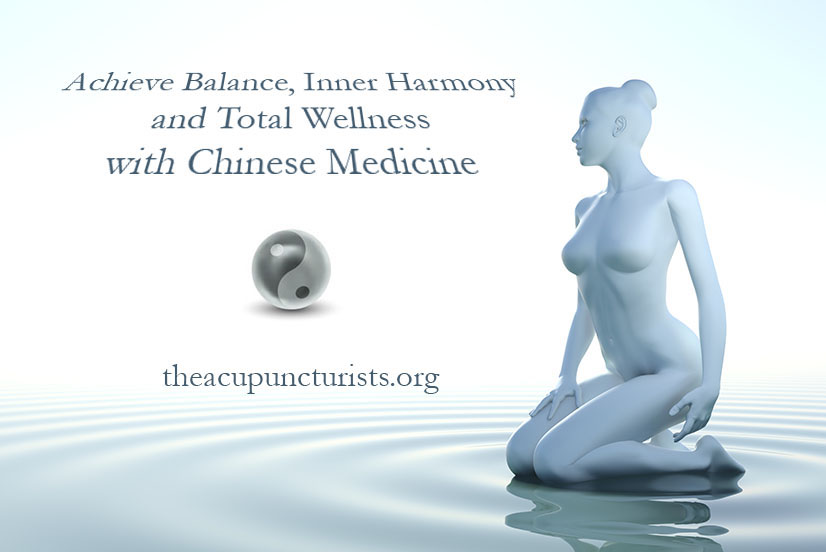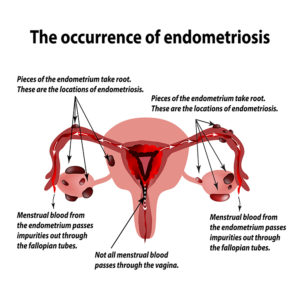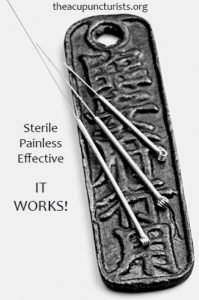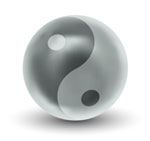 What is Endometriosis? Endometriosis, also called “endo,” is a condition where endometrial tissue grows outside of the uterus and forms tumor-like nodules. Endometrium is the tissue that normally lines the uterus or womb, but in endometriosis it is often located on the ovary or on the pelvic peritoneum–even on the bowels or umbilicus. These pieces of tissue outside the uterus bleed each month when a woman gets her period, causing severe pain and adhesions on the organs and surfaces in the abdomen.
What is Endometriosis? Endometriosis, also called “endo,” is a condition where endometrial tissue grows outside of the uterus and forms tumor-like nodules. Endometrium is the tissue that normally lines the uterus or womb, but in endometriosis it is often located on the ovary or on the pelvic peritoneum–even on the bowels or umbilicus. These pieces of tissue outside the uterus bleed each month when a woman gets her period, causing severe pain and adhesions on the organs and surfaces in the abdomen.
Endometriosis is a common health problem for women. It has been estimated that 15% of all women of reproductive age, or more than 6 ½ million women in the United States, have endometriosis. The major symptoms of endometriosis include abdominal pain, irregular menses, prolonged bleeding or bleeding in-between periods. Other symptoms are diarrhea or constipation, nausea or bloating that is worse with periods, and painful intercourse. Usually, endometriosis improves after menopause.
What causes Endometriosis?
 Currently most doctors think that these nodules of endometrium form from a back flow of the menstrual flow, which brings the shedding endometrium into the peritoneal cavity. While many women may have back flow, there is no clear reason why some develop the condition while others do not. Also tied to “endo” are elevated estrogen levels, a condition known as estrogen-dominance.
Currently most doctors think that these nodules of endometrium form from a back flow of the menstrual flow, which brings the shedding endometrium into the peritoneal cavity. While many women may have back flow, there is no clear reason why some develop the condition while others do not. Also tied to “endo” are elevated estrogen levels, a condition known as estrogen-dominance.
Stress is a contributing factor to estrogen-dominance because the body converts progesterone into cortisol when under stress, thereby depressing the level of progesterone in the body and leaving the estrogen elevated and imbalanced. Genetics perhaps also are risk factors. Abdominal surgery such as a C-section also increases a woman’s risk of “endo” because pieces of the endometrium can transfer outside the uterus.
Endometriosis and Infertility
Endometriosis is associated with an increased risk of having difficulty becoming pregnant, or infertility. Studies have shown that the amount of endometriosis that is seen at the time of laparoscopy is linked to future fertility. Many women are still able to get pregnant with endometriosis. However, endometriosis may affect as many as one in every two women with infertility. No one knows how exactly how endometriosis causes infertility. “Endo” can cause a blockage of the fallopian tubes or ovaries, preventing the egg from traveling to the uterus as well as preventing fertilization. Also, if fertilization does occur, the deformed lining of uterus can make embryo implantation difficult.
Related – Learn about Acupuncture for Infertility
Western Medicine Treatment of Endometriosis and Side Effects
The main treatment for endometriosis is birth control pills (BCP). They help regulate the estrogen by shutting down ovary function and replacing the body’s estrogen with a low-dose pill containing an estradiol and progesterone. BCPs have many side effects. Some of them include weight gain, nausea, migraines, decreased libido, depression and mood swings as well as increased risk of breast cancer and blood clots. Medications that block hormones such as GnRH agonists and Danazol are used with extreme effects such as osteoporosis and hirsutism.
All of these medications do not treat the underlying cause of “endo,” which may return after they are discontinued. Another option for severe pain and adhesions from “endo” is surgery such as laparoscopy to take out scar tissue or patches of endometrium. The surgery often brings pain relief which may be temporary if the endometriosis regrows. More severe cases can be treated with a full or partial hysterectomy or even severing the pelvic nerves.
Traditional Chinese Medicine (TCM) and Endometriosis Overview
TCM classifies endometriosis as a “blood stasis” condition, where blood is not moving properly, correlating with the Western medicine understanding of “endo” as well. In TCM, menstruation is closely related to the function of the liver, which regulates the Qi and blood circulation in the body. Elevated emotions such as anger, worry, or fear impair the Qi and blood circulation in the body. Just as cold temperatures cause water to freeze, blood circulation can be slowed in a “cold” body, causing the blood to collect instead of circulate. Blood stasis can also occur because of an underlying deficiency in the body.
TCM Pattern and Herbs
Herbs are very successful in treating endometriosis. A study in the International Journal of Clinical and Experimental Medicine in 2015 showed that taking Chinese herbal formulas reduced the thickness of the endometrium, increased the ovarian follicle size, and increased the pregnancy rates over the control group. Two great single herbs that break up blood stasis and reduce abdominal masses are San Leng and E Zhu. They are often paired together and added to formulas for blood stasis.
There are four main patterns of blood stagnation, and several formulas that address these patterns specifically.
1. Qi Stagnation and Blood Stasis: Symptoms: PMS symptoms such as moodiness, breast distention, severe pain in the abdomen worse with pressure, pain in the rib cage especially before periods, bitter taste in the mouth, all worse with stress and emotions, purple tongue with dark purple spots, and a wiry and thin or wiry choppy pulse.
Formula: Ge Xia Zhu Yu Tang is a blood-moving formula that aids healthy circulation below the diaphragm. Along with many herbs that move blood, there are herbs in the formula that also regulate the movement of Qi. Another formula that moves blood is Xue Fu Zhu Yu Tang which focuses more on the chest area and the liver circulation and less on the lower abdomen. For this formula, the tongue would be dark red with purple spots.
2. Internal Cold and Blood Stasis: Symptoms: pain before or after menstruation, worse with cold and pressure, better with warmth, cold limbs, watery menstruation with blood clots, loose stool, pale complexion with a pale purple tongue with red spots and white tongue coating, and a wiry string taut pulse.
Formula: The number one formula is Shao Fu Zhu Yu Tang, which warms the uterus and abdomen, relieves pain, and moves the blood. Another formula, Dang Gui Si Ni Tang, is excellent for warming the internal cold and improving circulation especially when there is more blood deficiency present. Wen Jing Tang is an excellent formula for lower abdomen cold and feverish feelings in the evenings with long term deficiency. This formula moves blood less than the first formula.
3. Kidney Deficiency and Blood Stasis: Symptoms: pain during and after menstruation, low back, hip or knee pain, history of irregular periods or miscarriage, scanty flow with black-colored clots, a dark complexion, dizziness or tinnitus, a pale tongue with a white coating, and a thin choppy pulse.
Formula: Hu Po San is an important formula to treat the underlying weakness in the reproductive system and encourage circulation in the lower abdomen.
4. Qi Deficiency and Blood Stasis: Symptoms: pain during and after menstruation, better with pressure and warmth, often accompanied by a bearing down sensation, fatigue, loose stools, pale menstrual flow, worry or anxiety, a pale tongue with teeth marks on the sides, and a weak pulse.
Formula: Tao Hong Si Wu Tang builds up the qi and blood while breaking up the stagnation. Another formula, Ju Yuan Jian, focuses more on the Qi deficiency and bleeding especially geared for menstrual disorders.
Acupuncture Treatment with Endometriosis
 Acupuncture is very effective in treating endometriosis because one of its main functions is to bring more blood and circulation to the area being treated. Many acupuncturists use extra points on the abdomen called Zi Gong “Palace of the Child” and Ti Tuo “Lift and Support.” Both points increase circulation to the uterus, ovaries, and abdomen and even regulate hormones. These points can be massaged daily; they are approximately four finger-widths down from the navel, and four finger-widths lateral from the center of the abdomen. Acupuncture can also treat the underlying condition that caused the blood stasis. Most importantly, acupuncture reduces stress to help restore the hormonal balance in the body.
Acupuncture is very effective in treating endometriosis because one of its main functions is to bring more blood and circulation to the area being treated. Many acupuncturists use extra points on the abdomen called Zi Gong “Palace of the Child” and Ti Tuo “Lift and Support.” Both points increase circulation to the uterus, ovaries, and abdomen and even regulate hormones. These points can be massaged daily; they are approximately four finger-widths down from the navel, and four finger-widths lateral from the center of the abdomen. Acupuncture can also treat the underlying condition that caused the blood stasis. Most importantly, acupuncture reduces stress to help restore the hormonal balance in the body.
An additional therapy that may be used with blood stasis, especially if there is an underlying “cold” condition is moxibustion, which is mugwort. This Chinese herb provides warmth just above the skin and is usually utilized during an acupuncture treatment.
Related – Learn about Acupuncture for Endometriosis
Nutrition and Lifestyle Support
There are many nutritional and lifestyle factors that help endometriosis. From a nutritional standpoint, avoid cold temperature foods such as raw vegetables and salads, iced beverages, and ice cream. It is also important to avoid sweeteners and eat only complex carbohydrates because glucose spikes cause stress in the body. Increase the amount of cruciferous vegetables such as broccoli, brussel sprouts, and kale. These veggies are aromatase inhibitors that reduce estrogen dominance and help regulate the thickness of the endometrium. Also, eating seaweed and healthy fats can help, too. Reducing stress is the number one lifestyle recommendation. Meditation, prayer, yoga, qigong, and acupuncture are great at reducing the stress hormone cortisol in the body. Moderate exercise also helps. To prevent the back flow of endometrium into the abdomen, it is recommended to avoid using tampons or having intercourse during menstruation. Lastly, avoid alcohol and caffeine; not only do they stress the body, but they tax the liver, which is the main organ that breaks down excess estrogens and regulates the Qi and blood.
Related – Learn about Nutritional Support for Endometriosis
Conclusion
Endometriosis or “endo” doesn’t have to mean painful monthly cycles and infertility. Acupuncture, herbal formulas, nutrition and lifestyle changes can make all the difference to clear up endometriosis and help the body function properly. Most important is to get a clear diagnosis from a knowledgeable TCM physician who can apply the proper treatment to your unique underlying condition. Call The Acupuncturists today to schedule a free consultation. We have successfully treated many cases of endometriosis in the Margate, Coral Springs and Coconut Creek communities and we are confident that we can help you too.
References
- “Chinese Medicine Treatment of Endometriosis.” TCMWell, 4 May 2010, www.tcmwell.com/TCMAndLife/TCMFemale/Chinese-medicine-treatment-of-endometriosis.html.
- Dharmananda, Subhuti. “Chinese Herbal Therapy for Endometriosis.” Internet Journal of the Institute for Traditional Medicine and Preventative Care, May 2002, www.itmonline.org/journal/arts/endometriosis.htm.
- Ding, Zhaorong and Fang Lian. “Traditional Chinese medical herbs staged therapy in infertile women with endometriosis: a clinical study” International journal of clinical and experimental medicine vol. 8,8 14085-9. 15 Aug. 2015
- “Endometriosis.” Womenshealth.gov, U.S. Department of Health & Human Services, 16 Mar. 2018, www.womenshealth.gov/a-z-topics/endometriosis.
- Huang, Kee Chang. The Pharmacology of Chinese Herbs. 2nd Edition ed., CRC Press, 1999.
- Link, Lilli. “Hormonal Birth Control: The 20 Side Effects You Should Be Aware Of.” Parsley Health, 23 May 2018, www.parsleyhealth.com/blog/hormonal-birth-control-side-effects/.
- “Treating Endometriosis with TCM.” Acupuncture Wellness Center, LLC, Mandeville Acupuncture, mandevilleacupuncture.com/files/TCM/disease/Treating_Endometriosis_with_TCM.pdf.
- “What Are the Treatments for Endometriosis?” Eunice Kennedy Shriver National Institute of Child Health and Human Development, U.S. Department of Health and Human Services, 31 Jan. 2017, www.nichd.nih.gov/health/topics/endometri/conditioninfo/treatment.
- Zheng, Li, and Sara Allen. Acupuncture & Infertility. Lulu Press, 2018.
